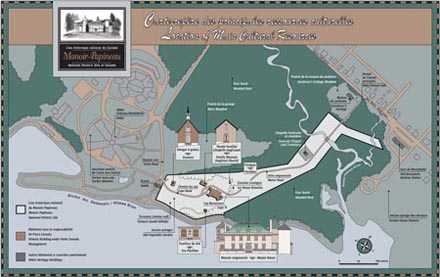1.3 Messages of National Historic Significance (Level 1)
At the Manoir Papineau National Historic Site of Canada, messages conveying the national historic significance of the site have been developed around five basic components drawn directly from the commemorative intent described earlier. These more general messages are aimed primarily at the general public and are as follows:
- The life and work of Louis-Joseph Papineau after he left the political scene represent his pursuit of certain ideals, his way of thinking and his tastes.
- The architecture of the Manoir Papineau reflects the social ambitions, tastes and personality of Louis-Joseph Papineau.
- The “Monte-Bello” estate was designed and developed by Louis-Joseph Papineau according to his vision of an ideal estate.
- Louis-Joseph Papineau saw the seigneurial system as one of the foundations of the French-Canadian identity.
- The Papineau family played a significant role in creating the estate.
To give visitors to the site a clearer understanding of the above messages of national historic significance, the following components will be developed in greater detail:
 Manoir Papineau - Location of the Main Cultural Resources For a larger version of this map click here. © Parks Canada |
- Louis-Joseph Papineau's role as defender of French-Canadian culture and institutions.
- The symbolic value of the manor house and outbuildings as they relate to seigneurial tenure.
- Papineau's views on the seigneurial regime.
- The context surrounding the abolition of the seigneurial regime.
- Louis-Joseph Papineau, 19th century thinker and man of culture, as reflected in the size and diversity of his personal library.
- Louis-Joseph Papineau and the location of his estate.
- Landscaping principles of the time that inspired Papineau.
- The aesthetic value that Papineau attached to the physical environment of the estate: stylistic and functional features of the various components of the estate.
- The architectural design of the manor house: the uniqueness of its picturesque composition; stylistic features of the manor and the layout of the rooms.
- Operation of the La Petite-Nation seigneury by Papineau.
- The ways in which Papineau involved members of his immediate family in developing the estate.
- Papineau's handing down of the estate to the next generation.
THE COMMUNICATIONS CHALLENGE
The main concern in presenting the Manoir Papineau National Historic Site of Canada is how to convey the site's heritage values through an external interpretation and messaging program centred around specific themes. The history of the site is imbued with Louis-Joseph Papineau's notoriety – he is best known as a politician and as leader of the Patriotes and to a lesser extent as seigneur of La Petite-Nation.
Recommendations of the Historic Sites and Monuments Board of Canada clearly state that Papineau's political career should be commemorated on the site of his Bonsecours Street residence in Montréal, while his life after leaving politics should be presented at Montebello. Nevertheless, Papineau was still the same man after 1846, and pursued the same political and social ideals. In the interest of the general public and visitors alike, it is essential that this continuity be expressed, although it need not be emphasized.
The message conveyed with respect to architecture is relatively complex. It will be a considerable challenge to explain how the manor house's architecture is a reflection of Papineau's social ambitions, tastes and personality without eclipsing the role played by the family or neglecting the influence of Amédée Papineau and the family in the building of the estate.
One of the major difficulties will be to bring out the multiple facets of a man who shone in such diverse areas: architect of a spacious manor, designer of the ideal estate, man of culture, great defender of the French-Canadian people and the seigneurial system, head of an illustrious family...
Finally, we need to introduce visitors to the concepts of “a seigneurial estate” and “a seigneury” and how they are linked to the present-day national historic site.
In other words, the problems involved in presenting the site's history lie primarily in how to adopt a messaging approach that respects the spirit of the site and meets the main expectations of the visitors.
Related links
- Foreword
- index
- Introduction
- page_0_1
- 1. Commemorative Integrity of the Site
- page_1_3_1
- 1.1 Commemorative Intent
- 1.2 Resources that Symbolize or Characterize the Site's...
- 1.4 The Site's Other Heritage Values (Level 2)
- 2. Analysis of the Current Situation
- 2.2 State of the Site's Commemorative Integrity
- 2.3 Condition of the Environment
- 2.4 Public Visitation and Use
- 2.5 Regional Tourism and the Strategic Position of the Site
- 3. Protection and Presentation of the Site
- 3.1 Concept of Protection and Presentation
- 3.2 Directions and Management Guidelines
- 4. Summary of the Environmental Impact Assessment
- 4.2 Methodology
- 4.3 Scope
- 4.4 Appropriateness of the Strategic Goals outlined in the...
- 4.5 Identification of Sources of Impact and Assessment of...
- 4.6 Cumulative Impacts
- 4.7 Mitigation Measures
- 4.8 Conclusion
- Conclusion
- Studies and Research Reports
- page2_2_1
- courriel-email
- Date modified :